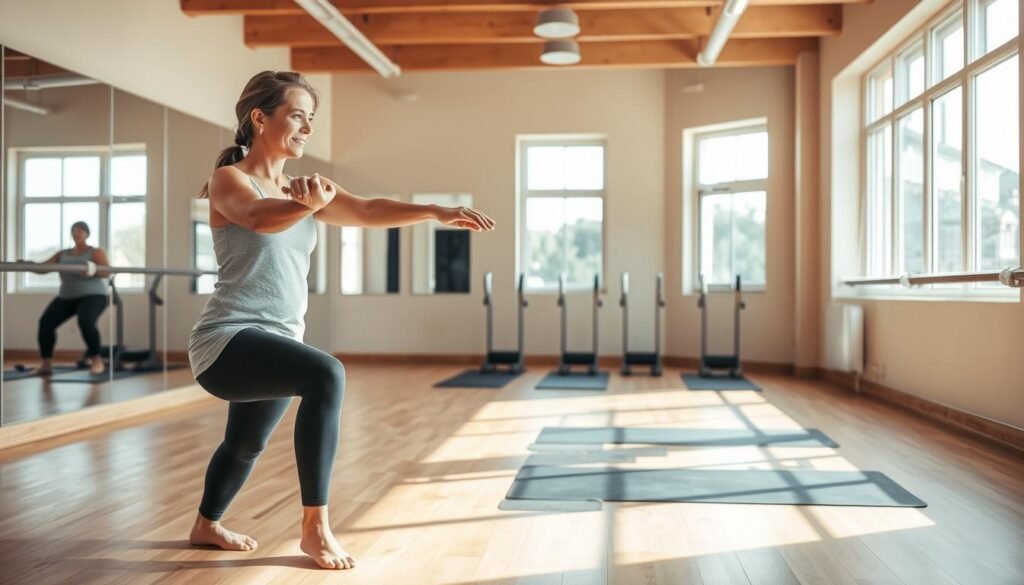
Can gentle movements actually reduce discomfort while improving joint stability? Many assume high-intensity workouts are the only path to strength, but research shows targeted, low-stress activities often deliver better results for those managing knee challenges. By focusing on muscle groups around the joint, we can build support without straining sensitive areas.
Strengthening the legs, hips, and core plays a critical role in maintaining healthy movement patterns. When muscles like the quadriceps and hamstrings are strong, they absorb stress that might otherwise settle in the knees. This approach aligns with physical therapy strategies for stiffness, emphasizing controlled techniques over aggressive routines.
We’ve prioritized methods backed by medical reviews and professional guidance. Whether sitting, standing straight, or lying down, each exercise adapts to individual needs. Always consult a healthcare provider before starting new routines—especially if discomfort persists during daily tasks like climbing stairs or bending forward.
Key Takeaways
- Strengthening muscles around the knee reduces strain on joints.
- Low-impact techniques improve stability without worsening discomfort.
- Professional guidance ensures exercises match personal health needs.
- Precautionary measures prevent injury during activity transitions.
- Consistent routines support long-term joint function and mobility.
Understanding Knee Pain and Its Impact
Why does knee discomfort persist even during routine activities? Daily strain from walking, climbing stairs, or standing for long periods often stems from hidden triggers. Overuse, arthritis, and muscle imbalances top the list of culprits, disrupting how joints handle pressure.
Common Causes and Risk Factors
Repetitive motions like running or squatting can inflame tendons and cartilage. Age-related wear weakens joint structures, while misaligned hips or feet shift stress to the knees. Weak leg muscles fail to absorb shock, letting pressure settle in sensitive areas.
| Cause | Impact | Prevention Tip |
|---|---|---|
| Overuse | Inflamed tendons | Limit high-impact activities |
| Arthritis | Cartilage erosion | Strengthen supporting muscles |
| Muscle Imbalance | Joint instability | Improve hip/foot alignment |
How Joint Stress Affects Mobility
When knees bear uneven weight—like in bent positions or side lunges—ligaments stretch beyond their capacity. This strain reduces flexibility and makes simple movements painful. Proper alignment during exercises keeps joints centered, preventing cartilage damage.
We encourage consulting healthcare providers to assess individual risks. Custom plans addressing foot posture, leg strength, and activity modifications often yield the safest results. Small adjustments today can preserve mobility for years.
The Role of Low-Impact Exercise in Knee Health
Low-impact workouts offer a safe path to stronger joints. These activities prioritize stability over intensity, allowing muscles to engage without harsh ground contact. Water-based movements like swimming or aqua aerobics let legs move freely while water buoyancy reduces pressure by up to 50% compared to land activities.

Building Strength Without Strain
Cycling and seated leg lifts strengthen thighs and hips while keeping joints aligned. These motions improve blood flow to stiff areas, which helps reduce swelling. A 2023 study showed participants who cycled 30 minutes daily reported 40% less discomfort during stair climbing within eight weeks.
Subtle movements matter. Side-lying leg raises activate hip stabilizers, preventing knees from bearing uneven weight. Focused muscle engagement in these workouts creates lasting support for daily tasks like standing or walking.
| Activity | Targeted Muscles | Joint Impact |
|---|---|---|
| Swimming | Quadriceps, calves | Minimal |
| Cycling | Hamstrings, hips | Low |
| Leg Lifts | Thighs, core | None |
Balance drills on soft surfaces—like foam mats—teach joints to handle shifts in weight safely. This adaptability reduces fall risks and keeps movements fluid. Always pair routines with professional guidance to match your body’s needs.
Best Exercise for People with Bad Knees
Strategic movements can rebuild stability while minimizing strain. We focus on precise alignment and gradual progression to protect sensitive joints during activity. Start with foundational motions before advancing to variations.
Step-by-Step Exercise Instructions
Supported Leg Extension:
- Sit upright with both feet flat on the floor
- Straighten one leg until parallel to the ground, keeping the thigh firmly pressed against the seat
- Slowly lower the leg over 3 seconds, maintaining control
- Repeat 8-12 times per side
| Variation | Focus Area | Adaptation |
|---|---|---|
| Seated March | Hip flexors | Use lighter weight or no resistance |
| Wall Slide | Thigh strength | Keep heels 12″ from wall |
| Stepbacks | Balance | Hold chair for support |
Adapting Techniques for Pain Relief
Modify movements based on comfort levels. If extending the leg back causes discomfort, try shorter ranges of motion. For floor exercises, place a folded towel under the knee for cushioning.
When standing, distribute weight evenly between both legs. Keep the front foot pointed straight ahead to prevent hip misalignment. Complete 2-3 sets of 10-15 reps, resting 30 seconds between rounds.
Always prioritize form over intensity. As strength improves, gradually increase duration—not resistance—to protect joint integrity.
Chair and Floor Exercises to Strengthen Knees
How can everyday furniture become a tool for joint health? Seated and ground-based routines let you engage muscles while minimizing pressure on sensitive areas. These methods build stability through controlled motions rather than forceful impact.

Effective Chair Exercises
Seated leg extensions strengthen thighs without straining joints. Sit upright with feet flat, then slowly straighten one leg until parallel to the ground. Hold for 3 seconds before lowering. Repeat 10 times per side.
For hip stability, try seated marches. Lift alternating knees toward the chest while keeping the back straight. Use armrests for support if needed. This movement improves circulation while maintaining proper alignment.
| Movement | Muscles Worked | Safety Tip |
|---|---|---|
| Side Leg Raises | Outer thighs | Keep hips squared forward |
| Heel Slides | Hamstrings | Place towel under knee |
Floor-Based Movements for Stability
Lie on your back for bridge poses. Bend knees with feet flat, then lift hips until shoulders and knees form a straight line. This activates core muscles while reducing stress on joints.
Modified planks on soft surfaces like carpets engage abdominal muscles without wrist strain. Keep elbows under shoulders and hold for 15-second intervals. Focus on steady breathing to maintain balance.
Always ensure the ground is stable before starting floor routines. Use yoga mats to prevent slipping, and pause if sharp discomfort occurs. Consistency with these techniques helps redistribute pressure away from sensitive areas during daily activities.
Safe Stretching and Flexibility Routines
Is stretching just a cool-down ritual, or does it actively protect vulnerable joints? Research reveals consistent flexibility work improves tissue elasticity and joint lubrication—critical factors for maintaining pain-free movement. Proper techniques prepare muscles for activity while aiding recovery.
Post-Exercise Stretching Benefits
Stretching after workouts reduces stiffness by 34% according to a 2024 Journal of Sports Medicine study. Holding positions for 20-30 seconds allows muscles to release tension gradually. This practice increases blood flow to sore areas, speeding up recovery and preventing imbalances that strain joints.
Focus on major muscle groups like hamstrings and calves. For example, a seated forward bend stretches the entire back of the leg while keeping knees aligned. Always breathe deeply during stretches to avoid muscle tension.
Dynamic and Static Stretch Methods
Dynamic moves—like leg swings—warm up tissues before activity. Static stretches work best post-workout when muscles are pliable. Alternate between methods based on your routine’s intensity and goals.
| Type | Purpose | Example | Duration |
|---|---|---|---|
| Dynamic | Improve mobility | Standing hip circles | 10 reps/side |
| Static | Enhance flexibility | Supine quad stretch | 25 seconds |
| Combined | Full-body prep | Lunge with torso twist | 15 sec/hold |
For floor stretches, try the figure-four pose: Lie on your back, cross one ankle over the opposite thigh, and gently pull legs toward the chest. Slowly lower into the position to avoid hip strain. This targets glutes and outer thighs while supporting knee alignment.
Modifying Workouts for Optimal Knee Support
How do you transform standard routines into joint-protective sessions? Personalization is key. We adjust three elements—repetitions, resistance, and stability—to match individual capabilities while safeguarding sensitive areas.
Customizing Reps, Sets, and Weight
Start by reducing repetitions. If standard leg lifts cause discomfort, cut reps by 30% and focus on controlled motion. A 2024 Journal of Orthopedic Research study found that slower movements with lighter weight improved joint stability 22% more than heavy lifting.
Balance training reshapes how pressure distributes across joints. Try single-leg stands near a wall, holding for 10-second intervals. This builds ankle and hip coordination, preventing knees from compensating during uneven surfaces.
| Approach | Benefit | Modification |
|---|---|---|
| Low Reps | Reduces fatigue | 8-10 per set |
| Light Weights | Protects cartilage | Use 1-3 lb ankle weights |
| Short Sets | Maintains form | 2 sets instead of 3 |
Listen to your body’s signals. Tingling or sharp pain means immediate adjustment. As experts recommend, prioritize fluid motion over speed. Gradually increase intensity only when movements feel effortless.
Pair these tweaks with seated variations for added support. A folded towel under thighs during chair exercises cushions joints while engaging core muscles. Consistency with modified routines builds lasting strength without setbacks.
Expert Insights and Medical Guidance
What do medical professionals prioritize when designing joint-friendly routines? Their focus centers on preserving mobility while minimizing wear-and-tear. We’ve compiled actionable strategies from orthopedic specialists and physical therapists to help you move smarter.
Doctor-Recommended Practices
“Consistency with low-stress movements matters more than intensity,” notes Dr. Alicia Torres, a sports medicine physician. She advises using chairs for seated leg lifts and light ankle weights (1-2 lbs) to build thigh strength without joint strain. These methods align with studies showing gradual resistance improves stability by 18% over six weeks.
Reducing Injury Risks
Avoid high-impact jumps, deep squats, or sudden pivots that twist the knees. Instead, opt for step-ups onto low platforms or side-lying hip abductions. Keep hands lightly resting on a wall for balance during standing movements.
| Risky Movement | Safer Alternative | Benefit |
|---|---|---|
| Running on pavement | Swimming or cycling | Reduces ground impact |
| Deep lunges | Shallow stepbacks | Protects cartilage |
| Plyometric jumps | Heel raises | Strengthens calves |
Therapy-Driven Adjustments
Physical therapists emphasize hip alignment. Try this: Stand with feet hip-width apart and shift weight evenly between both legs. Hold for 15 seconds, then alternate. This simple drill improves body awareness and prevents knees from overcompensating.
For floor work, place a folded towel under joints if discomfort arises. Always consult your doctor before progressing to weighted exercises—they’ll assess if your muscles and joints can handle increased resistance safely.
Conclusion
What final steps ensure lasting joint health while managing discomfort? Combining low-impact movements with precise positioning creates a foundation for sustainable progress. Focus on controlled motion—like slowly lowering the leg during seated extensions or shifting weight evenly when standing straight. These habits protect vulnerable areas while building strength.
Always prioritize alignment. Whether adjusting your heel placement or holding positions during floor exercises, proper form prevents strain. If pain arises when moving one leg, modify the motion or consult your doctor. Research confirms that gradual progression—not intensity—yields lasting results.
We encourage integrating these strategies into daily routines. Start with short reps, emphasize muscle engagement over speed, and use chairs or walls for stability. Small, consistent efforts compound into improved mobility and reduced discomfort over time.
Remember: joint health thrives on patience and professional guidance. Before advancing routines, discuss adjustments with a healthcare provider. With mindful practice, you’ll reinforce the body’s natural support systems while maintaining active independence.
